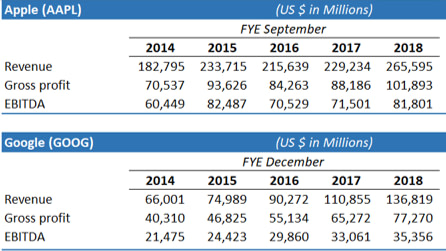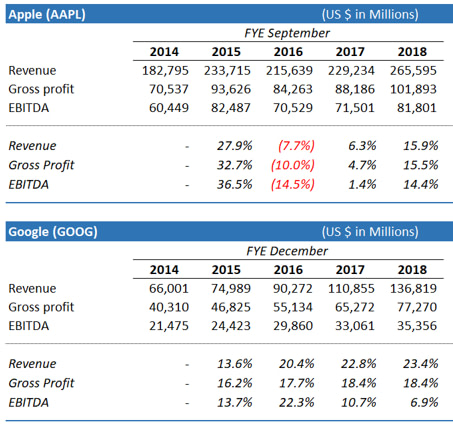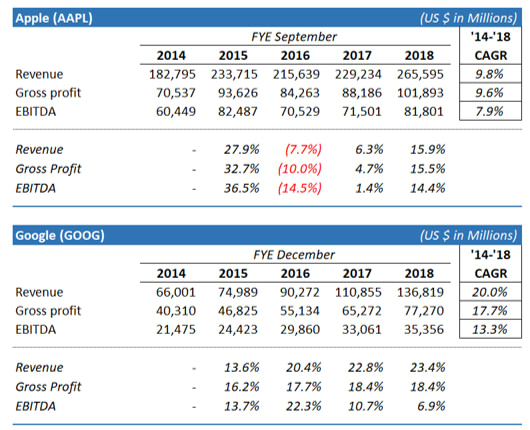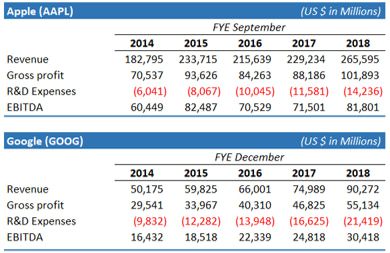As an investor, you should be digging into a company’s financial statements.
However, you can’t look at these financials in isolation – it’s important to compare a company’s results to other companies in the selected industry, companies outside of the industry, and against other years to determine whether or not that company might actually be an attractive investment.
Apples to Apples
This causes difficulties since it’s hard to compare companies of different sizes.
👉 For example:
If Company A has $3,000,000 of debt outstanding and Company B has $30,000,000 of debt outstanding, is Company A less risky than Company B?
We have no way of knowing, because we don’t know the cash positions of Companies A and B, how profitable Companies A and B are, etc.
Fortunately, there are two forms of analysis that we can perform that will help us look at income statements and balance sheets of different sizes so that we can compare apples to apples. They are: horizontal analysis and vertical analysis.
Both are very easy to understand. Let’s start with horizontal analysis.
What is Horizontal Analysis?
Horizontal analysis, also called time series analysis, focuses on trends and changes in numbers over time. Horizontal allows you to detect growth patterns, cyclicality, etc., and to compare these factors among different companies.
As an example, let’s take a look at some income statement items for Apple and Google.

It’s almost impossible to tell which is growing faster by just looking at the numbers. So we have to do some calculations. We can perform horizontal analysis on the income statement by simply taking the percentage change for each line item year-over-year.

By using horizontal analysis, we can now clearly see that Google’s revenue, gross profit, and EBITDA grew faster than Apple’s in every year except for 2015 (and one EBITA exception in 2018), with 2016 looking particularly rough for Apple.
We can even take this one step further by calculating the compound annual growth rate for each line item from 2014 to 2018. This tells us the average rate the companies grew in each year.
💡 Tip: You can do this in Excel by using the function: =rate(nper, pmt, pv, fv)

Our horizontal analysis (time series analysis) is now officially complete, and Google seems to be a standout winner, right?
But let’s not forget the other half of our analysis…
What is Vertical Analysis?
Vertical analysis, also called common-size analysis, focuses on the relative size of different line items so that you can easily compare the income statements and balance sheets of different-sized companies.
Let’s go back to our income statement items for Apple and Google.
Through our horizontal analysis, we know that Google has been growing at a faster and more sustained rate than Apple… but is it a relatively more profitable company? Do both companies’ profits seem to be sustainable?
To perform vertical analysis (common-size analysis), we take each line item and calculate it as a percentage of revenue so that we can come up with “common size” results for both companies.
Here are just the numbers once again. I’ve added a line for research & development costs as well.

Now, let’s divide each line item by revenue.

So what does this tell us?
For starters, in 2018, Apple generated $0.38 (in profit) for every $1 dollar in sales it made. Google did much better and generated $0.61 for every $1 in sales it made. However, let’s take a look at the elephant in the room: R&D expenses.
As we can see, Google’s R&D expenses are much higher than Apple’s. Apple is spending around 4.4% on R&D every five years, while Google is averaging a whopping 21.42%. These R&D expenses are significant given each company’s almost identical average EBITA (Apple: 32.62%, Google: 32.86%).
While Google does spend a lot more on R&D than Apple does, Google’s profit margins remain healthy and strong YoY. Its spending is increasing almost at the same pace as its earnings (when averaged). Google is in a good phase of business at the moment, and will likely continue to expand and announce new products and tech as they normally do.
However, Google’s stock price is significantly more than Apple’s. This can obviously be a big barrier to entry to investors wanting to get in on a business like Google.
Apple
Apple’s gross profit has declined has bounced up and down a few points in the last five years, while its R&D expenses have increased from 3.3% to 5.4% over the same time period. This could suggest that Apple is facing tough competitive pressures. Why?
- Trends in gross margin generally reveal how much pricing power a company has. Because Apple’s gross margin is declining, this probably means that (a) Apple is dropping the price of its products to match lower-cost competitors, (b) Apple’s costs to produce its products are increasing and Apple is unable to increase prices to offset this, or (c) a combination of both.
- This increase in R&D suggests that Apple is doubling down its efforts to create new and innovative products to offset its competition.
Putting it all Together
So, which is better: Google or Apple? Obviously, that is up for the individual investor to decide, as each person values different things in a business.
As stated before, this method is best used when comparing similar companies apples to apples. No two companies are the same, and this analysis shows only a very small piece of the overall pie when determining whether a company is a good buy, or not.
Horizontal and Vertical Analysis Workbook
If you want to experiment on your own, you can download the excel document I used for this article below. Use it as a template, and feel free to add and subtract things as you wish, as there is so much more information that can be gleaned from more input data!

You can make a copy of the Google Spreadsheet by clicking File > Make a copy from the menu.
The Value Investing 101 Series
For more great how-to articles in our Value Investing 101 series, be sure to check out:
- How to Determine a Discount Rate
- Value Investing 101: Intrinsic Value
- What is Value Investing
- How Warren Buffett Thinks About Risk
- A Brief Guide to Merger Arbitrage

The Ultimate Guide to Value Investing
Do you want to know how to invest like the value investing legend Warren Buffett? All you need is money to invest, a little patience—and this book. Learn more
























